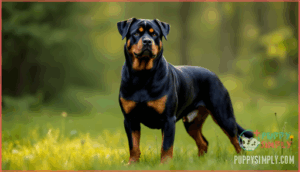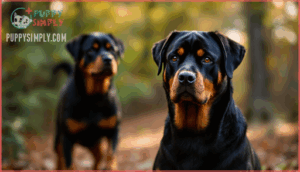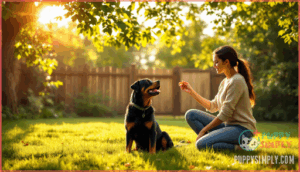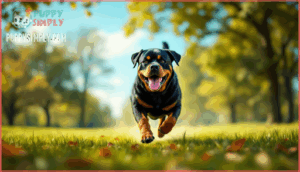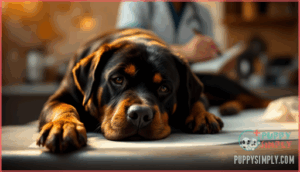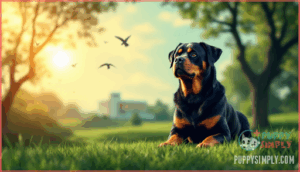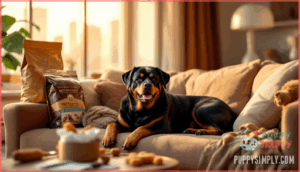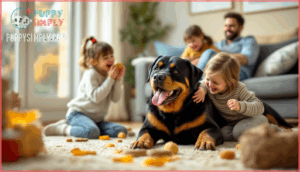This site is supported by our readers. We may earn a commission, at no cost to you, if you purchase through links.

These powerful dogs descended from Roman drover cattle herders, and they’ve retained that intense work ethic and protective instinct over millennia.
Before you bring one home, you need to understand what you’re committing to: a breed that demands consistent leadership, substantial exercise, and early socialization to channel their natural guarding behaviors appropriately.
Their average lifespan of 8-10 years is shorter than many breeds, largely due to their predisposition to joint dysplasia, obesity, and cancer—conditions that responsible ownership can help mitigate.
Whether a Rottweiler fits your household depends on your experience level, lifestyle, and willingness to invest both financially and emotionally in a dog that will bond intensely with your family while remaining naturally wary of strangers.
Table Of Contents
- Key Takeaways
- Rottweiler Breed Overview
- Appearance and Physical Traits
- Temperament and Personality
- Training and Socialization Needs
- Exercise and Activity Requirements
- Common Health Issues in Rottweilers
- Life Expectancy and Wellness
- Cost of Owning a Rottweiler
- Is a Rottweiler a Good Family Pet?
- Frequently Asked Questions (FAQs)
- What are the best ways to find a reputable Rottweiler breeder?
- How can I introduce a Rottweiler puppy to my children and other pets?
- Where can I find Rottweiler rescue organizations to adopt from?
- Are Rottweilers good dogs for first-time owners?
- What grooming routine do Rottweilers need regularly?
- Can Rottweilers adapt to apartment living conditions?
- How do Rottweilers behave around other dogs?
- What are the best food brands for Rottweilers?
- Do Rottweilers require professional training or classes?
- Conclusion
Key Takeaways
- Rottweilers demand a substantial financial commitment of $1,500-$2,500 upfront and nearly $5,000 annually, with lifetime costs reaching $16,000-$18,000 over their 8-10 year lifespan—expenses driven primarily by veterinary care for breed-specific conditions like hip dysplasia, obesity, and cancer.
- This breed’s protective instincts and territorial behavior require experienced ownership with consistent leadership, daily structured exercise exceeding 60 minutes, and early socialization starting in the first three to four months to prevent fear-based aggression and reactivity toward strangers and other dogs.
- Rottweilers face significant health challenges including cancer rates five times higher than general canine populations (particularly osteosarcoma affecting 5-12% of the breed), joint dysplasia in 17-22% of dogs, and obesity prevalence of 30-40%—all conditions requiring proactive veterinary monitoring and preventive care.
- These dogs form intensely loyal family bonds but aren’t suitable for first-time owners or passive households, as their 95-135 pound muscular build, guardian heritage, and need for constant training make them incompatible with inexperienced handlers or homes lacking space, time, and structured routines.
Rottweiler Breed Overview
Before you bring a Rottweiler into your home, you’ll want to understand where this breed comes from and why it’s become such a fixture in American households.
The Rottweiler’s journey from ancient Rome to modern-day America tells you a lot about what makes these dogs tick. Let’s start with the breed’s roots and how it earned its place as one of the country’s most recognizable companions.
History and Origins
Rottweilers trace their lineage back to the drover dogs of ancient Rome, where they marched alongside legions and helped herd cattle across the Alps into what’s now southern Germany. Once settled in the town of Rottweil, these working dogs evolved into the breed we recognize today. Their breed development centered on practical tasks:
- Driving cattle to market through rough terrain
- Pulling carts loaded with butchered meat
- Guarding money pouches tied to their collars
- Protecting livestock from predators and thieves
- Serving as reliable companions to tradesmen
This historical significance shaped their strength, intelligence, and unwavering work ethic—traits that remain embedded in the breed’s character.
Popularity in The U.S
Today, Rottweilers rank among the top ten most popular breeds in the United States, earning their place through decades of proven service as working dogs, loyal family protectors, and adaptable companions. American Kennel Club registration data consistently reflects this breed’s popularity, with thousands of Rottweilers registered annually.
Pet ownership trends show families value their balanced temperament—protective yet manageable with proper training. Their dog breed characteristics appeal to owners seeking both security and companionship.
Appearance and Physical Traits
Rottweilers have a striking, unmistakable look that makes them stand out in any setting. Their powerful build and distinctive coloring reflect the breed’s working heritage and natural strength.
Let’s break down the key physical traits that define this impressive breed.
Size and Weight Differences
When you’re considering a Rottweiler, you’ll quickly notice that this isn’t a one-size-fits-all breed—males and females can differ dramatically in both stature and bulk. Understanding these size variance patterns helps you prepare your home and budget accordingly.
- Males: Stand 24–27 inches tall, weighing 95–135 pounds with substantial muscle mass
- Females: Measure 22–25 inches, usually 80–100 pounds with leaner body proportions
- Growth patterns: Rottweilers reach full height by 12–18 months but continue building muscle mass until age two
- Weight factors: Genetics, diet, and exercise greatly influence final adult size in this large breed
Coat Color and Markings
Your Rottweiler’s striking appearance doesn’t stop at size—the breed’s coat follows a strict color formula that’s immediately recognizable to anyone familiar with working dogs. You’ll see a sleek, short black coat with rust-colored markings positioned in specific locations. These rust markings appear on the cheeks, eyebrows, legs, chest, and beneath the tail—deviations from this pattern don’t meet breed standards.
| Feature | Description |
|---|---|
| Base Color | Solid black with glossy finish |
| Rust Markings | Tan to mahogany shades on defined areas |
| Fur Texture | Short, dense, and weather-resistant |
| Coat Pattern | Black base with symmetrical rust points |
| Marking Variations | Minimal—standard locations only |
The Rottweiler breed characteristics include color genetics that produce remarkably consistent results, making this working breed instantly identifiable.
Distinctive Features
Beyond the classic color pattern, a Rottweiler’s most defining trait is the blocky, powerful head that draws the eye before you notice anything else. These Rottweiler physical attributes set the breed apart:
- Broad, massive skull with pronounced cheek muscles
- Dark brown, almond-shaped eyes expressing alertness
- Compact, muscular body proportions showing working heritage
- Distinctive triangular ears that fold forward
This muscle structure and head shape reflect generations of breeding for strength and endurance.
Temperament and Personality
Understanding a Rottweiler’s temperament helps you know what to expect when bringing one into your home. These dogs have distinct personality traits shaped by their protective heritage and deep attachment to family.
Let’s look at the key aspects of their character and how they usually behave.
Loyalty and Family Bonding
Few breeds form bonds with their families as intensely as Rottweilers do—these dogs don’t just live with you, they become devoted to you in a way that’s both extraordinary and deeply rewarding. This loyalty trait stems from their working heritage, where canine behavior evolved through close human partnership.
Your Rottweiler’s family ties develop through consistent Rottweiler care and positive bonding tips like daily interaction and reward-based Rottweiler training, creating emotional support that defines the Rottweiler temperament.
Protective Instincts
That unmistakable vigilance—the steady gaze tracking movement at your door, the shift in posture when footsteps approach—reveals the protective instinct hardwired into every Rottweiler’s temperament.
These guard dog traits manifest as territorial behavior that’s manageable through watchdog training and early socialization.
Without proper Rottweiler training, defensive reactions can escalate, turning protective measures into problematic dog behavior that complicates daily life and increases stress for both you and your pet.
Behavior With Strangers and Pets
Strangers trigger wariness in Rottweilers, while same-sex dogs often spark dominance challenges—a behavioral reality rooted in the breed’s guardian lineage and territorial drive. You’ll manage these guarding instincts through consistent socialization techniques:
- Controlled introductions to unfamiliar people reduce stranger aggression
- Supervised pet interactions prevent fear-based behaviors
- Early exposure to diverse environments shapes Rottweiler temperament and behavior
- Positive reinforcement during encounters builds confidence in your dog’s behavior
Training and Socialization Needs
Your Rottweiler’s future behavior hinges on what you teach them early—and how you teach it. Training a Rottweiler isn’t just about commands; it’s about shaping a confident, well-adjusted companion who knows how to navigate the world safely.
Here’s what you need to focus on to raise a Rottweiler you can trust in any situation.
Importance of Early Socialization
Socializing your Rottweiler during the first three to four months of life isn’t just helpful—it’s the difference between raising a confident companion and dealing with a reactive, fearful adult dog.
Puppy socialization lays the groundwork for behavioral development by exposing your dog to different people, environments, and canine interaction experiences. This critical window prevents fear-based responses and aids aggression control throughout adulthood.
Without proper early exposure, Rottweiler temperament and behavior can shift toward territorial overprotectiveness.
Effective Training Techniques
Training a Rottweiler well starts with understanding that their intelligence works both for and against you—they’ll learn what you teach them just as quickly as they’ll figure out what they can get away with. Positive reinforcement and clicker training work best because Rottweilers respond to rewards, not force.
Focus on obedience commands early—sit, stay, and heel build the foundation for behavior modification later. Consistency matters more than intensity in dog training techniques.
Preventing Aggression
If you skip early socialization or allow your Rottweiler to rehearse dominant behaviors unchecked, you’re basically teaching aggression through neglect. Watch for aggression signs like stiff posture, growling, or resource guarding—these aren’t temperament quirks you can ignore.
Use calming techniques and positive reinforcement to redirect canine behavior before it escalates. If dog aggression persists despite consistent Rottweiler training and care, behavioral therapy with a certified professional can prevent serious problems.
Exercise and Activity Requirements
Rottweilers aren’t couch potatoes—they’re powerful, high-energy dogs that need consistent physical activity to stay healthy and happy. Without proper exercise, they can become bored, destructive, or develop behavioral problems that make life difficult for everyone.
Let’s look at what it takes to keep your Rottweiler physically and mentally satisfied.
Daily Exercise Needs
Your Rottweiler needs at least an hour of vigorous physical activity every day to stay healthy, happy, and out of trouble. Daily walks won’t cut it alone—these powerful dogs thrive on exercise routines that include jogging, running alongside a bike, or swimming.
Without adequate physical activity, your Rottweiler can develop destructive behaviors like excessive chewing or barking, so consistent outdoor play isn’t optional—it’s essential for proper dog care.
Suitable Activities and Sports
Beyond the treadmill of daily walks, Rottweilers excel in structured activities like agility training, herding trials, and competitive obedience work that channel their natural strength and intelligence.
Water sports like dock diving satisfy their exercise needs while protecting joints, and hiking adventures provide both physical challenge and dog socialization opportunities.
These canine sports and activities prevent boredom while meeting your Rottweiler’s demanding exercise requirements through purposeful work.
Mental Stimulation
While physical workouts tire a Rottweiler’s body, puzzle toys, scent work, and obedience drills engage the sharp mind that can turn destructive when left idle. Cognitive training through brain games and structured playtime activities prevents behavioral problems while strengthening your emotional bond.
Incorporating social interactions during training sessions meets both canine health and wellness needs, since mental enrichment is as critical as physical conditioning for this intelligent working breed.
Common Health Issues in Rottweilers
Like all large breeds, Rottweilers face certain health challenges that you should know about before bringing one home. Understanding these conditions helps you plan for veterinary costs and catch problems early.
Let’s look at the most common health issues affecting this breed.
Hip and Elbow Dysplasia
Among orthopedic concerns in Rottweilers, joint health problems stand out. Hip dysplasia affects roughly 17-22% of the breed, while elbow dysplasia shows moderate involvement with a mean grading score of 1.04. About 12% of affected dogs develop both conditions simultaneously, complicating arthritis management.
You’ll face surgical options ranging from $1,200 to $7,000 per procedure, though conservative therapies often come first. Understanding these canine hip dysplasia causes—primarily genetic, with heritability estimates near 0.58—helps you anticipate potential Rottweiler health issues before symptoms emerge. For more information on managing hip dysplasia, consider dog hip surgery costs and procedures.
Obesity and Diet Concerns
Weight control becomes a defining factor in your Rottweiler’s health trajectory, with obesity rates in the breed hovering around 30-40% and directly amplifying the strain on already vulnerable joints.
Healthy feeding requires precise portion control and nutrient balance customized to your dog’s activity level.
Implement structured diet plans focusing on lean protein and measured calories—usually 1,800-2,400 daily depending on size—to guarantee weight management facilitates obesity prevention and overall dog health.
Cancer Risks and Other Conditions
Neoplasia (cancer) stands as a leading cause of death in Rottweilers, with some forms striking the breed at rates five times higher than the general canine population. Osteosarcoma risk escalates dramatically—affecting 5–12% of Rottweilers—and usually emerges around age 8, causing limb pain and aggressive spread.
Key cancer symptoms and breed-specific health issues include:
- Hemangiosarcoma: Blood vessel tumors targeting spleen, liver, or heart with subtle early signs
- Lymphoma: Affects up to 10% of cancer cases, often involving multiple lymph nodes
- Mast cell tumors: Skin cancers requiring prompt surgical removal for best outcomes
- Bloat (GDV): Life-threatening stomach twisting demanding immediate emergency intervention
- Cruciate ligament rupture: Common knee injury necessitating surgical repair
Health screening through genetic testing and routine veterinary exams facilitates disease prevention by catching abnormalities early, though only 19% of exceptionally long-lived Rottweilers (over 13 years) succumb to canine cancer versus 82% dying at typical ages. Understanding dog cancer rates is vital for effective health management.
Life Expectancy and Wellness
Rottweilers usually live 8 to 10 years, though several factors can influence how long your dog stays by your side.
Understanding what affects their lifespan and how regular veterinary care plays a role can help you make informed decisions about your dog’s health.
Let’s look at what shapes a Rottweiler’s longevity and the steps you can take to support their wellness throughout their life.
Average Lifespan
Most Rottweilers live between 8 and 10 years, which is typical for large-breed dogs. Understanding this lifespan helps you plan for their long-term care and recognize age-related health trends early.
Mortality rates in Rottweilers often link to conditions like cancer and joint disease, but the aging process varies by individual.
Proactive Rottweiler health and care strategies—including monitoring canine health markers—can support quality of life throughout your dog’s lifespan.
Factors Influencing Longevity
Several factors act like a dial on your dog’s lifespan—genetics, body condition, and preventive care each play a measurable role in how long your Rottweiler stays by your side. Genetic factors determine predisposition to health issues like cancer, while nutrition impact and lifestyle choices directly affect obesity risk.
Environmental effects, including exercise consistency and stress reduction, influence canine health outcomes. Regular health monitoring catches developing conditions before they compromise lifespan.
Preventive Veterinary Care
Think of preventive care as your Rottweiler’s maintenance schedule—skipping routine checkups might not show problems immediately, but catching hip dysplasia or early-stage cancer during regular veterinary visits can add years to their life.
Essential preventive veterinary care includes:
- Vaccination schedules customized to your dog’s exposure risk
- Annual health checkups with orthopedic screening after age five
- Dental care every six to twelve months to prevent systemic infection
- Parasite control protocols for heartworm and tick-borne diseases
- Nutrition advice adjusted for life stage and body condition
Cost of Owning a Rottweiler
Owning a Rottweiler isn’t just about the upfront puppy price—you’ll need to budget for ongoing expenses that add up over your dog’s lifetime. From food and vet bills to grooming and emergency care, the financial commitment is substantial.
Here’s what you can expect to spend at each stage of Rottweiler ownership.
Initial Purchase Price
Acquiring a Rottweiler puppy represents a significant financial investment, with prices generally ranging from $1,500 to $4,000 depending on lineage, breeder reputation, and whether you’re looking at a companion animal or show-quality dog.
Reputable breeders’ fees reflect health screenings, vaccination protocols, and socialization efforts that protect your investment. Adoption prices through rescue organizations usually run lower—often $300 to $800—and include spay/neuter procedures.
Review purchase contracts carefully, as they outline health guarantees and return policies that safeguard both parties.
Annual and Lifetime Expenses
Once you bring your Rottweiler home, ongoing pet ownership costs add up quickly. Monthly costs usually range from $295 to $560, covering everything from food expenses to veterinary fees and grooming. Budget planning becomes essential when you consider the lifetime investment—$16,000 to $18,000 over 8–10 years, excluding emergencies that average $631 per incident.
Here’s what drives those dog ownership costs:
- Food expenses: $60–$150 monthly for premium, high-protein large-breed diets
- Routine veterinary care and expenses: $50–$120 monthly for preventive medications, vaccinations, and checkups
- Dog care and grooming: $30–$100 monthly, depending on professional services versus home maintenance
- Treats and enrichment: $20–$50 monthly supporting training and dental health
- First-year totals: $2,465–$4,770 including supplies, initial veterinary care, and training investments
Insurance options can offset unexpected medical bills, making financial preparedness part of responsible ownership.
Pet Insurance Considerations
Given those recurring expenses, pet insurance deserves a close look—monthly premiums averaging $56 can shield you from the financial shock of emergency surgeries, cancer treatments, or orthopedic procedures that easily exceed $5,000.
When evaluating pet insurance options, compare policy coverage for breed-specific conditions like hip dysplasia and osteosarcoma. The claim process matters too—reputable insurance for pets reimburses 70–90% of covered costs after your deductible, turning unpredictable veterinary expenses into manageable accident plans that support responsible pet ownership.
Is a Rottweiler a Good Family Pet?
Rottweilers can make excellent family pets, but they’re not the right fit for every household. Your home environment, daily routine, and experience with dogs all play a role in whether this breed will thrive with your family.
Let’s look at what you need to think about before bringing a Rottweiler into your home.
Suitability for Families With Children
When supervised properly and trained with care, Rottweilers can be excellent family dogs, but they’re not the right fit for every household with kids. Their size and strength mean parental responsibilities include:
- Teaching children appropriate interaction and respecting boundaries
- Never leaving young kids unsupervised with any large breed
- Confirming early Rottweiler socialization needs are met consistently
- Monitoring family dynamics to prevent territorial behavior
Kid-friendly traits emerge through proper pet ownership responsibilities and understanding dog temperament.
Home and Lifestyle Requirements
Before you commit to a Rottweiler, take an honest look at your living space and daily routine—this breed thrives in environments that match their physical needs and energy levels. Your living arrangements should include secure fencing and adequate square footage for a large dog. While apartments can work, houses with yards better support Rottweiler exercise requirements and socialization needs.
| Requirement | Ideal Condition |
|---|---|
| Space Needs | House with fenced yard preferred over apartment |
| Yard Requirements | Minimum 6-foot secure fence for home safety |
| Dog Exercise | 60+ minutes daily walking, jogging, or play |
| Family Dynamics | Active household with consistent routines |
| Care Requirements | Time for training, grooming, and veterinary visits |
Owner Responsibilities
Owning a Rottweiler isn’t just about providing food and shelter—it’s a commitment that demands your time, consistency, and willingness to be the calm, confident leader this powerful breed needs every single day. Responsible pet ownership requires attention to multiple aspects of dog care:
- Veterinary Care and Vaccination Schedules – Maintain regular wellness exams and follow recommended immunization protocols
- Nutrition Planning – Feed a balanced diet appropriate for large breeds to prevent obesity
- Pet Grooming – Brush weekly and trim nails regularly for health maintenance
- Emergency Preparedness – Keep a first-aid kit and know your emergency veterinary contact
- Pet Ownership and Insurance – Consider coverage to manage unexpected medical costs
Your commitment to these dog ownership responsibilities directly impacts your Rottweiler’s quality of life and longevity.
Frequently Asked Questions (FAQs)
What are the best ways to find a reputable Rottweiler breeder?
Look beyond glossy websites and bold promises—finding a responsible Rottweiler breeder requires detective work.
Start with the American Rottweiler Club’s breeder directory, verify health clearances for hip and elbow dysplasia, and always visit kennels in person to observe breeding standards firsthand.
How can I introduce a Rottweiler puppy to my children and other pets?
Start puppy socialization early—introduce your Rottweiler to children through supervised, calm interactions using positive reinforcement.
For pet harmony, allow gradual, controlled meetings with existing pets in neutral spaces while monitoring body language closely.
Where can I find Rottweiler rescue organizations to adopt from?
Adopt, don’t shop" rings true when seeking a loyal companion. You’ll find breed-specific rescue groups through online shelter listings and national networks dedicated to Rottweiler rehoming.
Many offer foster care programs, guidance on the adoption process, and expert rehoming tips for these devoted dogs.
Are Rottweilers good dogs for first-time owners?
Rottweilers aren’t usually recommended for first-time owners. These powerful dogs need experienced management, consistent training, and confident leadership—skills that develop through prior dog ownership experience. Without that foundation, managing their protective instincts becomes challenging.
What grooming routine do Rottweilers need regularly?
Your Rottweiler needs weekly brushing for shedding control and coat maintenance, monthly nail care, and regular ear cleaning to support skin health.
These basic dog grooming needs prevent infections and maintain your Rottweiler’s overall wellness effectively.
Can Rottweilers adapt to apartment living conditions?
While technically possible, apartment living isn’t ideal for this large breed. Rottweilers need substantial space requirements for movement and exercise.
High-rise living poses challenges with noise levels, as their protective instincts may trigger barking in urban environments, disturbing neighbors.
How do Rottweilers behave around other dogs?
They can be territorial and may show aggression toward same-sex dogs without early, consistent canine socialization.
Pack dynamics matter—your Rottweiler needs supervised animal interactions and proper dog training to guarantee breed compatibility and prevent behavioral issues.
What are the best food brands for Rottweilers?
You’ll find quality dog food brands like Open Farm, Merrick, Diamond Naturals, and Orijen frequently recommended for Rottweiler nutrition.
Choose formulas with balanced meals supporting joint health and proper protein levels for their working-dog metabolism.
Do Rottweilers require professional training or classes?
Professional training isn’t technically mandatory, but it’s honestly one of the smartest investments you’ll make. Obedience classes and puppy socialization programs give you canine coaching expertise—teaching proper dog training methods while preventing behavioral issues before they start. Structured training tips beat guesswork every time.
Conclusion
Owning a Rottweiler isn’t like adopting just any dog—it’s more like entering a partnership with a living security system that demands respect, structure, and unwavering consistency. Understanding rottweilers as pets cost life expectancy and temperament means accepting that these dogs won’t thrive in passive households or with inexperienced owners who mistake their loyalty for automatic obedience.
You’ll invest thousands annually, commit to daily training, and outlive your companion by decades. But for those prepared to lead confidently and meet their substantial needs, Rottweilers reward you with unshakeable devotion and protection few breeds can match.
- https://vomhausestan.com/how-much-does-a-german-rottweiler-cost/
- https://spotpet.com/blog/breed-tips/how-much-does-a-rottweiler-cost
- https://www.petinsurancequotes.com/blog/dog-breeds/rottweiler-pet-insurance
- https://en.wikipedia.org/wiki/Rottweiler
- https://nativepet.com/blogs/health/rottweiler-life-expectancy


